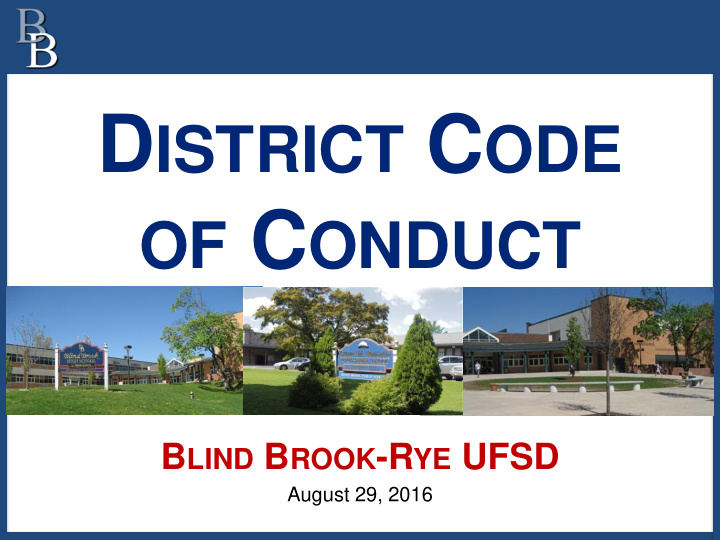



D ISTRICT C ODE OF C ONDUCT End-of-Year Summary 2015-2016 B LIND B ROOK -R YE UFSD August 29, 2016
Committee Members Students Administration Carly Kabot Patricia Lambert, HS Sammy Landino Todd Richard, MS Julia Sunshine Derek Schuelein, MS/HS Tracy Taylor, BMP/RSS Parents Teachers Felicia DePaola Kaitlin Carey, MS/HS Abbie Fleishaker Helen Kinnen, BMP/RSS Lauren Haimes Michael Martino, HS Rachel Leland Patrick Mulvany, HS Margaux Sayer Christine Sabatella, HS Jen Schlactus Cher Treacy, MS
Review of Policies NYS Ed Law Section 2801 - Codes of Conduct on School Property BOE Policy 3410 – Code of Conduct on School Property 7310 – School Conduct and Discipline 7310R – Discipline Comparator Districts’ Codes Chappaqua Scarsdale Edgemont Briarcliff Manor New York State School Boards Association (NYSSBA) Sample Annotated Code of Conduct 3
Code of Conduct Table of Contents 3 Introduction 3 Definitions 5 Student Rights and Responsibilities 6 Essential Partners 11 Student Dress Code 12 Prohibited Student Conduct & Disciplinary Penalties 18 Reporting Violations 19 Dignity for All Students Act (DASA) 20 Disciplinary Penalties, Procedures and Referrals 28 Academic Integrity 31 Alternative Instruction 31 Discipline of Students With Disabilities 39 Corporal Punishment 39 Transportation 42 Athletic Code of Conduct 42 Student Searches and Interrogations 45 Visitors to Schools 46 Public Conduct on School Property 48 Dissemination and Review 4
Updated Sections “ Definitions ” Reorganized existing language and added updated terms. “Students’ Rights and Responsibilities” Described access to information and expectations of mutual respect. “ Essential Partners ” Parents Teachers Building Administrators Superintendent Board of Education 5
Prohibited Conduct and Penalties LEVEL I “ Misbehaviors classified in this level represent relatively minor infractions of established procedures that impact the orderly operation of the school and its educational process. Generally speaking, this level contains behaviors which are disorderly, disruptive, or not conducive to a learning environment. The frequency of their occurrence shall determine the appropriate disciplinary response and their reclassification at a higher level .” LEVEL II “This level includes misbehaviors of a frequency and severity which tends to disrupt the learning climate of the school and seriously affect the student’s own education or that of others. Level II infractions may be the result of Level I misbehaviors which go unremedied or unmodified .” LEVEL III “These acts are more serious because their consequences may have a lasting effect on the individual or may pose a threat to the health and safety of others in the school. In some cases, outside agencies may have to be contacted or notified.” LEVEL IV “Represented in this level are acts that are very serious. Included are those which present a direct and immediate threat to the welfare of others or may result in violence to persons or property. So serious are they that in most cases they require administrative action that calls for the immediate removal of the student from school and the intervention of the police .” 6
Academic Integrity Review Prior Cases 44 cases reported from 2012 through 2015 BOE Policy 3410 – Code of Conduct on School Property 7310 – School Conduct and Discipline 7310R – Discipline Decisions of the Commissioner 23 NY Ed Dept Rep 126 30 NY Ed Dept Rep 245 39 NY Ed Dept Rep 310 Decision #14149 Comparator Districts’ Academic Integrity Codes Ardsley Byram Hills Briarcliff Manor Bronxville Chappaqua Edgemont Mamaroneck Scarsdale 7
Academic Integrity Review The academic integrity report was shared and discussed with all stakeholders as follows: Faculty: High School – PLC meetings Middle School – Faculty meeting Parents: High School – Shared Decision Making Committee meeting Middle School – Shared Decision Making Committee meeting Students: Congress Meeting and 2 committee meetings 8
Academic Integrity Policy Middle and High School First Offense: • Addressed by teacher • Reduced grade or zero • Parents notified and incident reported to administration. • Written reflection may be required. • Note: Administration may be involved at this stage depending upon the specific details of the incident. This may elevate a first offense to a higher level of intervention and consequence. Second Offense: • Parents and student meet with the academic integrity committee consisting of the Assistant Principal, Department Coordinator, and Teacher. • In addition to the above procedure, that committee may recommend: counseling, removal from extra-curricular activities, removal from the class, detention, or suspension. Third Offense (High School Only): • As above, plus possible withdrawal from consideration for special honors and awards. • In the case of severe or pervasive dishonesty which calls into question a student’s academic standing, the committee may recommend that the infractions be disclosed to colleges. 9
Academic Integrity Violations Incidents Reported SY 2015-2016: High School: 23 Middle School: 6 SY 2014-2015: High School: 15 Middle School: 2 SY 2013-2014: High School: 11 Middle School: 4 SY 2012-2013: High School: 10 Middle School: 2 10
Questions 11
Recommend
More recommend